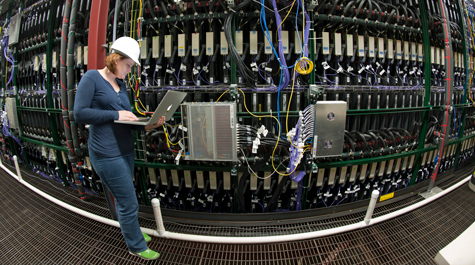NOvA experiment reports strong evidence of antineutrino oscillation
For more than three years, scientists on the NOvA collaboration have been observing particles called neutrinos as they oscillate from one type to another over a distance of 500 miles.
Now, in a new result unveiled today at the Neutrino 2018 conference in Heidelberg, Germany, the collaboration has announced its first results using antineutrinos and has seen strong evidence of muon antineutrinos oscillating into electron antineutrinos, a phenomenon that has never been unambiguously observed.
“This first data set from antineutrinos is a just a start to what promises to be an exciting run,” said NOvA co-spokesperson Tricia Vahle of William & Mary. “It’s early days, but NOvA is already giving us new insights into the many mysteries of neutrinos and antineutrinos.”
Vahle, professor of physics at William & Mary and longtime NOvA participant, became a NOvA co-spokesperson on March 21. William & Mary has a sizeable presence on NOvA and even maintains a remote control facility in Small Hall to monitor the experiment based in Batavia, Illinois.
In addition to Vahle, other William & Mary participants include Professor Jeff Nelson, postdoctoral researcher Alex Radovic and graduate student Marco Colo.
NOvA, based at the U.S. Department of Energy’s Fermi National Accelerator Laboratory, is the world’s longest-baseline neutrino experiment. Its purpose is to discover more about neutrinos, ghostly yet abundant particles that travel through matter mostly without leaving a trace.
The experiment’s long-term goal is to look for similarities and differences in how neutrinos and antineutrinos change from one type — in this case, muon — into one of the other two types, electron or tau. Precisely measuring this change in both neutrinos and antineutrinos and then comparing them will help scientists unlock the secrets that these particles hold about how the universe operates. Vahle explained that antineutrinos are a kind of antimatter.
“All the particles we know about have an antiparticle pair,” Vahle said. “The electron has the positron. There are protons and antiprotons. There are quarks and antiquarks. Antimatter isn’t that big of a mystery. It sounds kind of mysterious, but it’s relatively well understood.”
NOvA uses two large particle detectors — a smaller one at Fermilab in Illinois, and a much larger one 500 miles away in northern Minnesota — to study a beam of particles generated by Fermilab’s accelerator complex and sent through the Earth, with no tunnel required.
The new result is drawn from NOvA’s first run with antineutrinos, the antimatter counterpart to neutrinos. NOvA began studying antineutrinos in February of 2017. Fermilab’s accelerators create a beam of muon neutrinos (or muon antineutrinos), and NOvA’s far detector is specifically designed to see those particles changing into electron neutrinos (or electron antineutrinos) on their journey.
If antineutrinos did not oscillate from muon type to electron type, scientists would have expected to record just five electron antineutrino candidates in the NOvA far detector during this first run. But when they analyzed the data, they found 18, providing strong evidence that antineutrinos undergo this oscillation.
“Antineutrinos are more difficult to make than neutrinos, and they are less likely to interact in our detector,” said Fermilab’s Peter Shanahan, co-spokesperson of the NOvA collaboration. “This first data set is a fraction of our goal, but the number of oscillation events we see is far greater than we would expect if antineutrinos didn’t oscillate from muon type to electron. It demonstrates the impact that Fermilab’s high-power particle beam has on our ability to study neutrinos and antineutrinos.”
Although antineutrinos are known to oscillate, the change into electron antineutrinos over long distances has not yet been definitively observed. The T2K experiment, located in Japan, announced that it had observed hints of this phenomenon in 2017. The NOvA and T2K collaborations are working toward a combined analysis of their data in the coming years.
“With this first result using antineutrinos, NOvA has moved into the next phase of its scientific program,” said Jim Siegrist, associate director for high energy physics at the Department of Energy Office of Science. “I’m pleased to see this important experiment continuing to tell us more about these fascinating particles.”
NOvA’s new antineutrino result accompanies an improvement to its methods of analysis, leading to a more precise measurement of its neutrino data. From 2014 to 2017, NOvA saw 58 candidates for interactions from muon neutrinos changing into electron neutrinos, and scientists are using this data to move closer to unraveling some of the knottiest mysteries of these elusive particles.
The key to NOvA’s science program is comparing the rate at which electron neutrinos appear in the far detector with the rate that electron antineutrinos appear. A precise measurement of those differences will allow NOvA to achieve one of its main science goals: to determine which of the three types of neutrinos is the heaviest, and which the lightest.
Neutrinos have been shown to have mass, but scientists have not been able to directly measure that mass. However, with enough data, they can determine the relative masses of the three, a puzzle called the mass ordering. NOvA is working toward a definitive answer to this question. Scientists on the experiment will continue studying antineutrinos through 2019 and over the following years will eventually collect equal amounts of data from neutrinos and antineutrinos.
Joseph McClain contributed to this story.
















